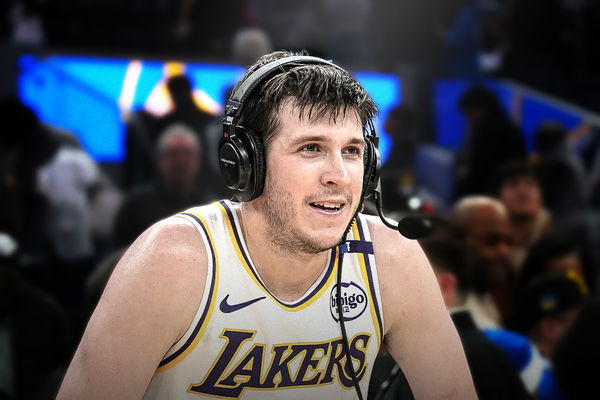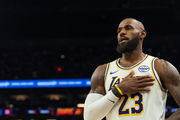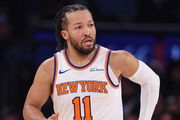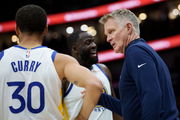
USA Today via Reuters
Jan 13, 2024; Salt Lake City, Utah, USA; Los Angeles Lakers guard Austin Reaves (15) reacts to being called for a foul against the Utah Jazz during the second quarter at Delta Center. Mandatory Credit: Rob Gray-USA TODAY Sports

USA Today via Reuters
Jan 13, 2024; Salt Lake City, Utah, USA; Los Angeles Lakers guard Austin Reaves (15) reacts to being called for a foul against the Utah Jazz during the second quarter at Delta Center. Mandatory Credit: Rob Gray-USA TODAY Sports
The Lakers are trying to fix what hasn’t worked, again. After another season that ended in postseason disappointment, the front office got aggressive. Thus far, they have added former Defensive Player of the Year Marcus Smart, Deandre Ayton, and brought in role players like Jake LaRavia. With LeBron James opting into the final year of his contract, the pressure to compete now is at an all-time high. But while the Lakers answered some of their biggest offseason questions, they may have created a new one.
Watch What’s Trending Now!
Or at least unearthed an uncomfortable truth. Someone from the starting lineup had to move. That someone, it turns out, might be Austin Reaves.
Reaves, who just averaged a career-high 20.2 points and 5.8 assists, is now being floated as the odd man out of a retooled starting five. And it’s not about talent. Just like Manu Ginobili once thrived leading the second unit for the Spurs, Reaves could give the Lakers a similar edge if he embraces it. Allen Sliwa reflected on Hoops Talk, a strategic mindset rather than one focused solely on talent. He argues that building a starting lineup shouldn’t be about simply putting your five best players on the floor.
ADVERTISEMENT
Instead, it should be about creating a group that fits together, players whose skill sets complement one another. In this case, Sliwa believes Rui Hachimura performs better when he starts, benefiting from the attention drawn by stars like LeBron James and Luka Doncic. Pulling Rui from the starting lineup could diminish his impact. On the other hand, Austin Reaves, a proven scorer and playmaker, has the skill set to thrive off the bench.
Sliwa suggests, “You could look off the bench and ask: are you now getting somebody in like Austin Reaves that could put up 20 a game, 25, 30 on any given night, and can he be going up against some of these other players and really go to work?”
ADVERTISEMENT

Reaves, like Ginobili before him, is at his best when the offense runs through him. Reading defenses, initiating action, controlling pace. But alongside high-usage stars like Luka Doncic and LeBron James, his role in the starting lineup often shrinks into one-dimensional spot-up shooting. That’s not where Reaves shines. Smart’s arrival changes the math. He brings much-needed perimeter defense, giving J.J. Redick an anchor to start games with intensity. That allows Reaves to lead the second unit, which was lifeless offensively last season, with freedom.
ADVERTISEMENT
It’s not about reducing his minutes, but rather about giving him the ball, the space, and the matchups to be the most dangerous version of himself. “If he’s healthy, he’s good to go, and he has a good camp, consider having Austin Reaves come off the bench and let Austin Reaves just go to work when he comes off the bench. Still going to play 30 minutes a night. Still going to probably be in there towards the end of games,” Sliwa added. “But I personally like that balance a little bit more.”
This setup lets Redick stagger Reaves and Doncic to avoid redundancy. Keeps Rui Hachimura in the starting lineup for size and spacing, and gives the Lakers the bench punch they’ve lacked. The Manu role isn’t a demotion; it’s a calculated move that could make Reaves the frontrunner for Sixth Man of the Year.
ADVERTISEMENT
Austin Reaves’ future in limbo amid contract standoff
Last month, Reaves declined a four-year, $89.2 million extension from the Lakers. He’s widely expected to decline his $14.8 million player option for 2026–27. His value is climbing, and Reaves knows it. A sixth-man role could potentially hurt his market value in the eyes of some, even if the minutes and impact remain high. Reaves holds most of the leverage right now. He’s outperformed his current deal, and teams across the league are keeping tabs.
NBA insider Jake Weinbach recently tweeted, “Austin Reaves’ situation with the Lakers is one to monitor across the league… If the two sides are far apart on extension talks, the Lakers may shop the value of the 27-year-old guard to avoid the possibility of losing him for nothing once 2026 free agency comes around.” The Lakers have two uncomfortable options. Either they can move him to the bench and risk alienating him during a critical contract year. Or keep him as a starter to appease him, even if it’s not the optimal basketball decision.
Top Stories
Paige Bueckers Gives a Peek Into Her Minnesota Christmas Away From WNBA

LeBron James Drops Retirement Hint as He Shuts Down Claims of All-Time Record

WNBA Expansion Draft: Predicting 5 Players Every Team Will Protect

Knicks Exploring Ways to Cut Ties With $5.5M Player, Putting Fan Favorite at Risk -Insider

Draymond Green Breaks Silence on Heated Steve Kerr Moment Leading to Exit From Warriors-Magic

And then there’s the third, more brutal option: trade him before the 2026 deadline and get something before potentially losing him for nothing. Given that LA is trying to maintain financial flexibility for the 2026 free agency class, the risk of losing Reaves is very real.
ADVERTISEMENT
Reaves hasn’t publicly wavered in his loyalty to the franchise. He’s said he wants to be a Laker for life. He’s excited about playing for J.J. Redick. But this situation is fluid, and with every week that passes without a new deal, the noise around a potential trade grows louder. “Austin Reaves’ situation with the Lakers is one to watch,” Weinbach continued. “He declined a four-year, $89.2M extension… and is expected to become an unrestricted free agent.”
The Lakers have made win-now moves, but the Reaves decision is looming. Whatever happens next, Austin Reaves’ future in LA is as complicated as it is critical.
ADVERTISEMENT
ADVERTISEMENT
ADVERTISEMENT

